Petrophysical Training
Licenses
|
 CORE ANALYSIS BASICS
CORE ANALYSIS BASICS
This page is an
overview of most of the laboratory procedures available to
describe rock samples taken from wellbores. More detailed
descriptions of the techniques are presented in other
Section sof this Chapter -- see links at the right.
 CONVENTIONAL CORE ANALYSIS
CONVENTIONAL CORE ANALYSIS
Routine, or
conventional, core analysis provides geologists and engineers
with "hard data" related to the downhole environment.
Generally considered to be the "ground truth", Conventional core
data is used to calibrate log analysis results, reservoir
simulations, and stratigraphic correlations.
 Core
Plugging and Slabbing Core
Plugging and Slabbing
Core sample physical properties are usually
determined from 1.5" diameter plug samples cut
from bulk subsurface core. For whole-core
analysis, the cylindrical core material is cut
lengthwise into two slabs using a specially
designed saw. The slabbed cores can be displayed
for description, viewing, or documentation.
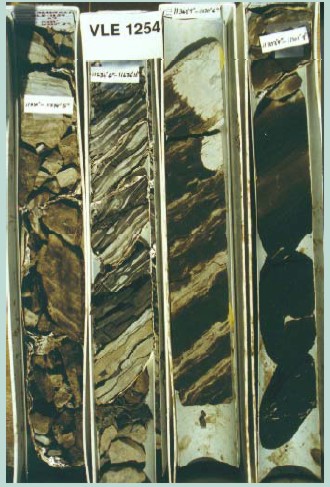  Core Gamma Ray
Core Gamma Ray
A spectral
gamma ray log of the core is essential for depth
control to well logs. It is helpful in
understanding radioactive sands and carbonate
reservoirs.
 Basic Properties Basic Properties
Basic properties are measured on cleaned, dry
samples drilled from the whole core by diamond
bit core drills. Standard basic property
measurements are helium porosity and
permeability (Klinkenberg corrected), grain and
bulk density, residual oil and water saturation,
and visual lithology descriptions.
 Sidewall Core
Analysis Sidewall Core
Analysis
Analysis of both rotary and percussion sidewall
cores include bulk volume, porosity, fluid
content, laser grain size analysis, air
permeability (empirical estimate), and
photography (colour and UV).
 Core
Photography
Core
Photography
Digital Imagery provides an
easily accessible visual
record of a core, core
plugs, well cuttings, and
thin sections. Imagery is
digitized at either
microscopic or
near-microscopic resolution.
It
also serves as a source
of petrologic and petrophysical data. Under
ultra-violet light, oil
fluoresces, so photos in
both natural and UV light
need to be taken.
|
 X-Ray Computed
Tomography (CT) ANALYSIS
X-Ray Computed
Tomography (CT) ANALYSIS
X-ray computed tomography is now the
industry-wide technology for whole-core
inspection at the macro level, core-log correlation, and plug
sample characterization. Standard output
includes CT radiograph plus axial CT scans. Plug
scans may also include both longitudinal and
axial CT scans.
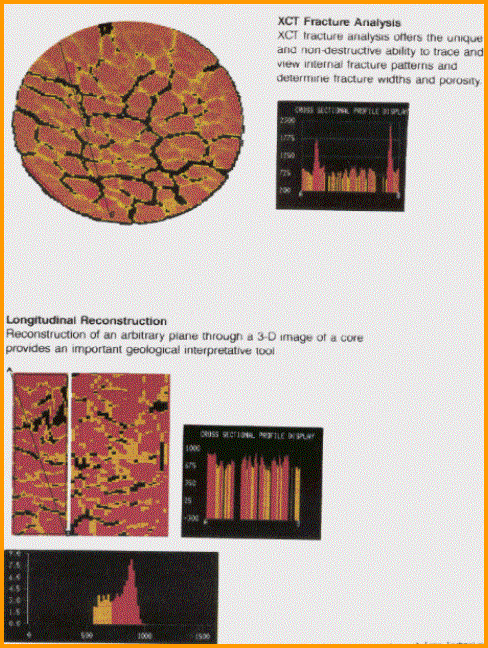
X-Ray CT Scan
Images
 Digital Rock Physics from Macro, Micro, and Nano CT Analysis
Digital Rock Physics from Macro, Micro, and Nano CT Analysis
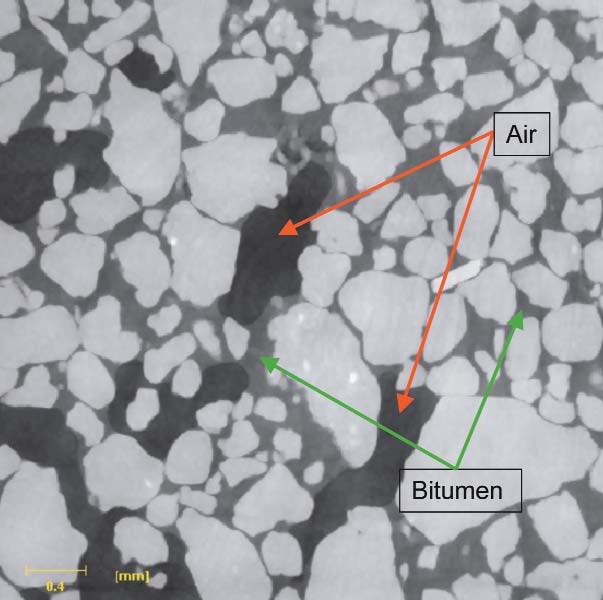 Digital Rock Physics is a term
used to describe more detailed analysis of CT Scan images. First,
higher resolution images than conventional CT scans are made. Then
the pore size and shape are quantified in three dimensional space,
and a series of well defined equations are used to generate computed
rock properties, such as porosity, permeability, capillary pressure,
relative permeability, electrical properties, mineralogy, elastic
properties, and so on. Some of these can be defined in the three
primary directions (X, Y, and Z directions). Total, effective,
connected, unconnected, and fracture porosity can be derived.
Permeability as low as a few nanoDarcies can be detected. Samples
can be taken from cores, core plugs, or drill cuttings. The latter
allows measurement of quantitative rock properties without coring -
a significant cost saving on current wells and an invaluable source
of new information on older wells. Digital Rock Physics is a term
used to describe more detailed analysis of CT Scan images. First,
higher resolution images than conventional CT scans are made. Then
the pore size and shape are quantified in three dimensional space,
and a series of well defined equations are used to generate computed
rock properties, such as porosity, permeability, capillary pressure,
relative permeability, electrical properties, mineralogy, elastic
properties, and so on. Some of these can be defined in the three
primary directions (X, Y, and Z directions). Total, effective,
connected, unconnected, and fracture porosity can be derived.
Permeability as low as a few nanoDarcies can be detected. Samples
can be taken from cores, core plugs, or drill cuttings. The latter
allows measurement of quantitative rock properties without coring -
a significant cost saving on current wells and an invaluable source
of new information on older wells.
  Digital Rock Physics
Digital Rock Physics
The list above shows the breadth of
quantitative data that can be developed from digital rock physics CT
scans. Considerable super-computer power is required to manipulate
the 3-D data set through the numerous heavy-duty equations. One day,
the technique will be turned inside-out, as was done for the NMR
method, and micro CT scans will become a borehole well log. In the
meantime, grap your sample chips and start re-logging those critical
unconventional reservoirs..
Macro Level Properties = 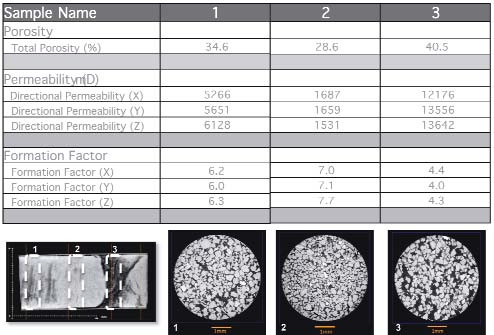
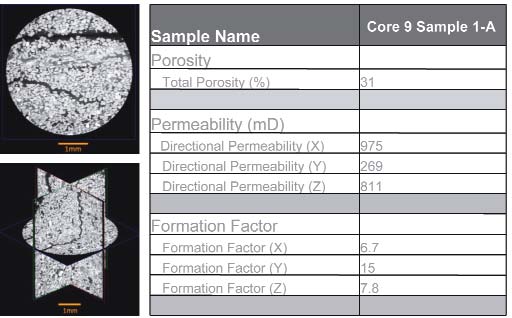  Micro Level Properties
Micro Level Properties
Nano Level Properties in Shale  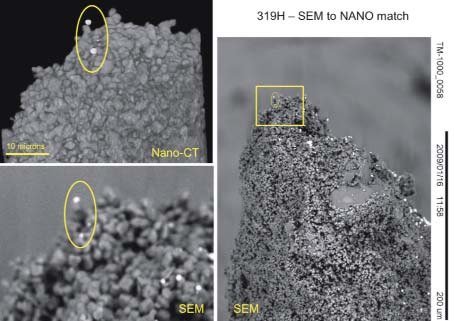
White = Porosity
 X- Ray Fluoroscopy
X- Ray Fluoroscopy
High-resolution fluoroscopy provides the ability
to perform quantitative image analysis,
including a high resolution density log of the
entire core. Each scan contains X-Ray density
standards. The log provides an important record
of variations in lithology and porosity
throughout the length of the core. This provides
approximate porosity and lithology estimates
before the core is even slabbed.
 SPECIAL CORE ANALYSIS MEASUREMENTS
SPECIAL CORE ANALYSIS MEASUREMENTS
Special Core
Analysis (SCAL) provides specific information to characterize a
particular rock property, or through a selection of specialized
tests, provides a more complete understanding of a reservoir rock.
 Electrical Properties
Electrical Properties
Electrical property measurements
are made using either the porous plate or dynamic displacement
technique. Most labs have the capacity to test using either 2 or 4 electrode measurements at reservoir
conditions. Data include resistivities (Rw, Ro, Rt), formation
factor (F), resistivity index (I), cementation and saturation
exponents (M and N), and CEC, Qv, and Co-Cw analysis for clay-corrections.
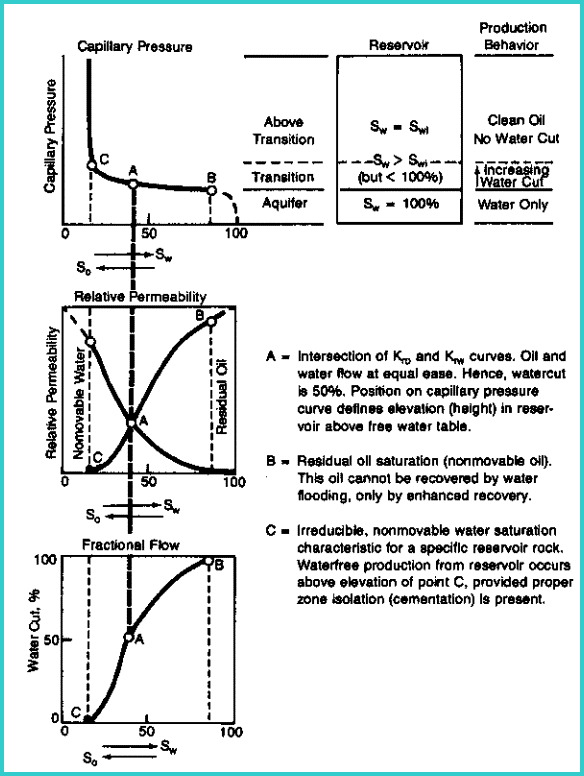  Capillary
Pressure
Capillary
Pressure
Capillary pressure measurements are available using porous plate,
high-speed centrifuge, or mercury injection techniques. Porous plate
measurements can be performed at ambient and/or elevated
temperatures. Centrifuge data is currently limited to ambient or
moderate temperatures. PTS is equipped with 2 automated
Micromeritics mercury injection porosimeters for testing at
pressures up to 60,000 psi.
 Relative
Permeability
Relative
Permeability
We encourage early consultation
with our clients in an effort to design relative permeability test
programs that are consistent with processes in the field. PTS offers
a full complement of relative permeability tests including:
- Steady state X-ray CT
monitored (7-point standard)
- Water-oil and
gas-oil, ambient and reservoir conditions
- Imbibition and
drainage cycling
- Unsteady state
(constant rate or constant pressure)
- Water-oil and
gas-oil, ambient and reservoir conditions
|
 Wettability Testing
Wettability Testing
Knowledge of the wettability of a reservoir rock is a key factor for
determining oil recovery mechanisms and making estimates of recovery
efficiency. PTS offers industry-standard Amott and Modified USBM wettability tests, including the USBM test at elevated temperatures.
For samples that have been subjected to weathering, PTS offers
sample restoration in crude oil at reservoir temperature.
 Pore Volume
Compressibility
Pore Volume
Compressibility
Hydrostatic pore volume compressibility testing is a routine
offering for 1-in., 1.5-in. and 2-in. diameter samples and pressures
up to 10,000 psi. Cyclic compression and decompression tests, as
well as failure point determination tests, are also available. PTS
has in-house capabilities to perform uniaxial or triaxial stress
testing. Advanced geomechanical determinations are also available.
 NMR Analysis
NMR Analysis
PTS Labs is equipped with a
state-of-the-art Maran Ultra NMR core analyzer, and flow-through
core holders capable of testing at both ambient and reservoir
conditions. For calibration with downhole logging tools, the
instrument can match pulsed NMR tool magnetic strength and T2 echo
spacing. NMR determinations include:
- Effective and
Free-Fluid Porosities
- Fluid Saturations &
Distributions
- Capillary-Bound Water
- Permeability
- Oil Viscosity
- Pore Size
Distribution & Geometry
- Free Fluids, Mobile
Oil, Gas & Water
- Clay Bound Water
- Producible Fluids and
Fluid Types
|
 PETROGRAPHIC ANALYSIS
PETROGRAPHIC ANALYSIS
Petrographical analyses is an essential service providing estimates
of pore size distribution, grain size, sorting, porosity and mineral
abundances, fabric, rock classification, porosity varieties and
abundances.
  Thin
Section Petrography
Thin
Section Petrography
Detailed thin
section analysis includes measurement of mean
grain size, sorting, and point count
determination of mineral abundances and porosity
(minimum 300 points per thin section). Results
include a determination of Vshale, shale
distribution, porosity varieties and abundances
with a discussion of diagenesis, diagenetic
sequence, porosity origins and development,
controls on porosity and permeability. Point
count data is presented in tabular form with
color photomicrographs accompanied by detailed
descriptions.

 X-Ray Diffraction Analysis
X-Ray Diffraction Analysis
XRD analysis
provides semi-quantitative determination of
sample mineralogy. Bulk and clay X-ray
diffraction analysis is performed to aide in
reservoir description and evaluation of
reservoir diagenesis. The data provided in
tabular format.
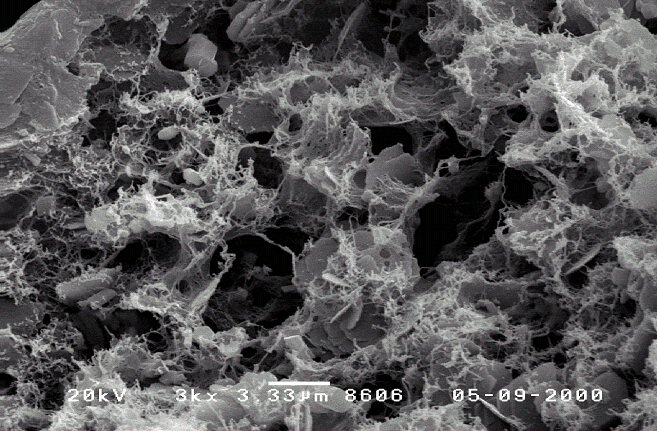  Scanning
Electron Microscopy Analysis
Scanning
Electron Microscopy Analysis
The data output includes two (2) photographs at
varying magnification documenting significant
rock properties, pores, pore throats, clays,
framework grains and cements. Deliverables
include a complete written description, and
elemental abundance from EDS analysis.
Back-scatter
SEM allows for the development of petrophysical
properties on cutting and percussion sidewall
cores where other measurements cannot be
accurately made. Analysis requires BSI on ultra
polished billet and SEM photomicrograph on fresh
surface. Data results are presented in both
tabular and graphical formats and includes:
-
Porosity
-
Porosity distribution (percent
primary intergranular and micro
porosity)
-
Permeability
-
Pore size distribution
-
Mean pore body diameter (ferret
diameter)
-
Mean pore throat diameter
-
Mean aspect ratio
-
Average coordination number
-
Pore shape factor
-
Capillary pressure curves
-
Formation factor ("m")
-
T-2 distribution plot
|
|
|
|

